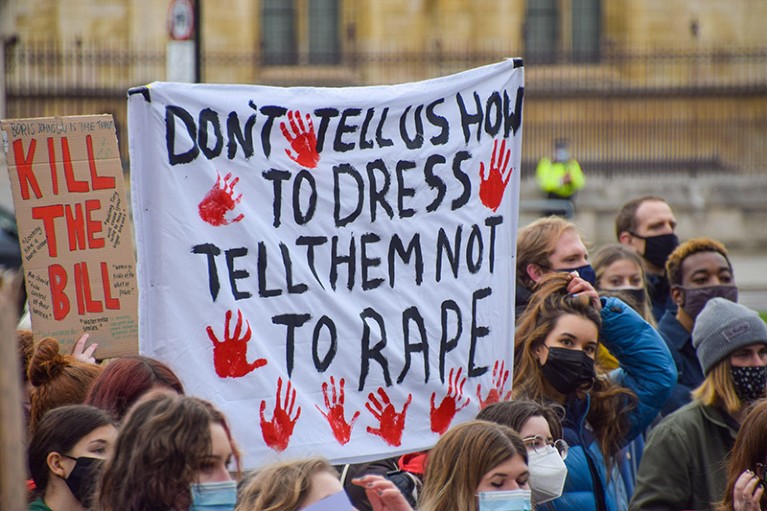
A 2021 protest in London to highlight sexual harassment.Credit: Vuk Valcic/Alamy
UK universities’ handling of reports of sexual assault and harassment is still a work in progress, with a huge disparity in how abuse complaints from staff and those from students are handled, research has found.
Higher Education After #MeToo, published by the 1752 Group, which campaigns against sexual harassment in academia in the United Kingdom, investigates how universities have been tackling gender-based violence or harassment (GBVH) since 2016. This was when Universities UK, the body that represents academic institutions in the country, published its Changing the Culture report on the issue, alongside guidance on how to handle alleged student misconduct.
The latest report, released this week, focuses on the reporting process. It finds that, although some institutions are providing good support to students who make complaints, “this does not appear to extend to support for staff” who report harassment or abuse.
Addressing GBVH is still a relatively new function for UK universities, one which has come to the fore only since the explosion of the #MeToo movement against sexual violence, which was accompanied by several high-profile cases. One such case was the University of Warwick ‘rape chat’ scandal in 2019: 11 male students exchanged racist and sexually explicit messages online about female students. It sparked a huge debate about sexual abuse on campuses across the country.
One of the most striking aspects of the findings was the variation in how institutions handled complaints — from how much money was invested in addressing GBVH, to whether institutions employed specialist staff members trained to oversee harassment cases, to institutions’ willingness to take robust action — says Anna Bull, the lead author and a researcher in sexual harassment in higher education at the University of York, UK.
She is also the director of research at the 1752 Group, which got its name from the amount of money — £1,752 (about US$2,230) — that Goldsmiths, University of London, allocated to the first UK conference on staff-to-student sexual abuse, in 2015.
The 80-page report is based on 25 interviews with staff members who handle GBVH complaints, and 27 interviews with people who reported abuse to their institutions. Six interviewees were members of staff targeted by other employees, 13 were students targeted by staff and 8 were students targeted by other students.
‘Work in progress’
Bull says that there is now more of a culture in which people are encouraged to speak up about GBVH, but “institutions aren’t always ready to handle the reports”.
“The formal reporting process is still a work in progress,” she says, adding that a lot of the work has focused on GBVH targeted at students, with most resources going into support services for this group. However, there has not been a strong focus on harassment aimed at staff. Human-resources departments, which handle staff complaints, have not seen similar levels of investment, she says. Bull’s earlier research on staff abuse of students, published in 2018, highlighted how early-career researchers occupy a grey area.

The University of Warwick plaza, where ‘rape chat’ protests took place in 2019.Credit: Jamie Gray/Alamy
“There’s as much of a power imbalance between senior staff and early-career researchers as between staff and students. They’re particularly vulnerable because they need allies and supporters to get into an academic career. They need to build networks, but the system is almost designed to make them vulnerable to abuse,” she says.
One of the common themes that emerged from the study was that complainants had few rights in the reporting process. “It’s a disciplinary process, so it’s all about the respondent, not the person who has made the complaint,” concludes Bull.
The report found that complainants often received little information on the progress or outcome of their case, with universities citing concerns over data-protection legislation. One of the interviewees, an early-career researcher who reported a senior staff member, saw the perpetrator’s statement only after she lodged a formal request. A female student who reported a male student found that he could submit questions to her at the disciplinary panel, but she wasn’t allowed to submit any herself.
Of the 27 cases covered in the report, just 3 of the complaints were fully upheld, or found to be valid after investigation. And in one of those cases, the complainant did not find out what sanctions were applied to the lecturer she had reported.
The report also highlights the huge toll of both undergoing and reporting abuse. Some complainants were forced to abandon their studies or move institutions. Others were even subject to further harassment for making a complaint.
Bull notes that it is hard to say whether the findings are representative of UK academia as a whole, because there are few data on the scale of GBVH at universities. The Office for Students — the regulator of higher education in England — is carrying out a prevalence survey, but it will cover only student experiences.
Fixing the problem
The report makes several recommendations. One is that GBVH should be seen as part of universities’ health and safety remit and be monitored by the Health and Safety Executive, the United Kingdom’s workplace-safety regulator. It also calls for more detailed guidance on how universities should handle GBVH complaints. For students, it says, this work could be led by the Office for the Independent Adjudicator for Higher Education. For staff, the Advisory, Conciliation and Arbitration Service, an independent public body that works to improve employer–employee relations, could take this on.
Bull says there is a strong principle of “institutional autonomy” among UK universities. “They don’t like being told what to do,” she says. “This is a complex area legally, socially and institutionally, and we need some kind of ongoing serious case-review panel that would highlight emerging issues and look at cases that have gone wrong.”
Sarah Bevan, a policy manager at Universities UK, says it is important to recognize how much progress has been made over the past few years, adding: “Some of the students in the report highlighted how they were supported by their universities and said there were a lot of specialist staff and support in place. I don’t think that would have been the case ten or even five years ago. But at the same time, there are a number of challenges, and we know we have a lot more work to do in this area.”
Bevan also says that, since Bull conducted her interviews in 2020 and 2021, Universities UK has published further guidance urging greater transparency and sharing of information about the outcomes of complaints. “Universities were quite risk averse, but we’re encouraging them to look at cases in the round — so rather than taking a blanket approach of a refusal to share anything, they should look at what information they can share and what would be helpful to complainants,” she says.
